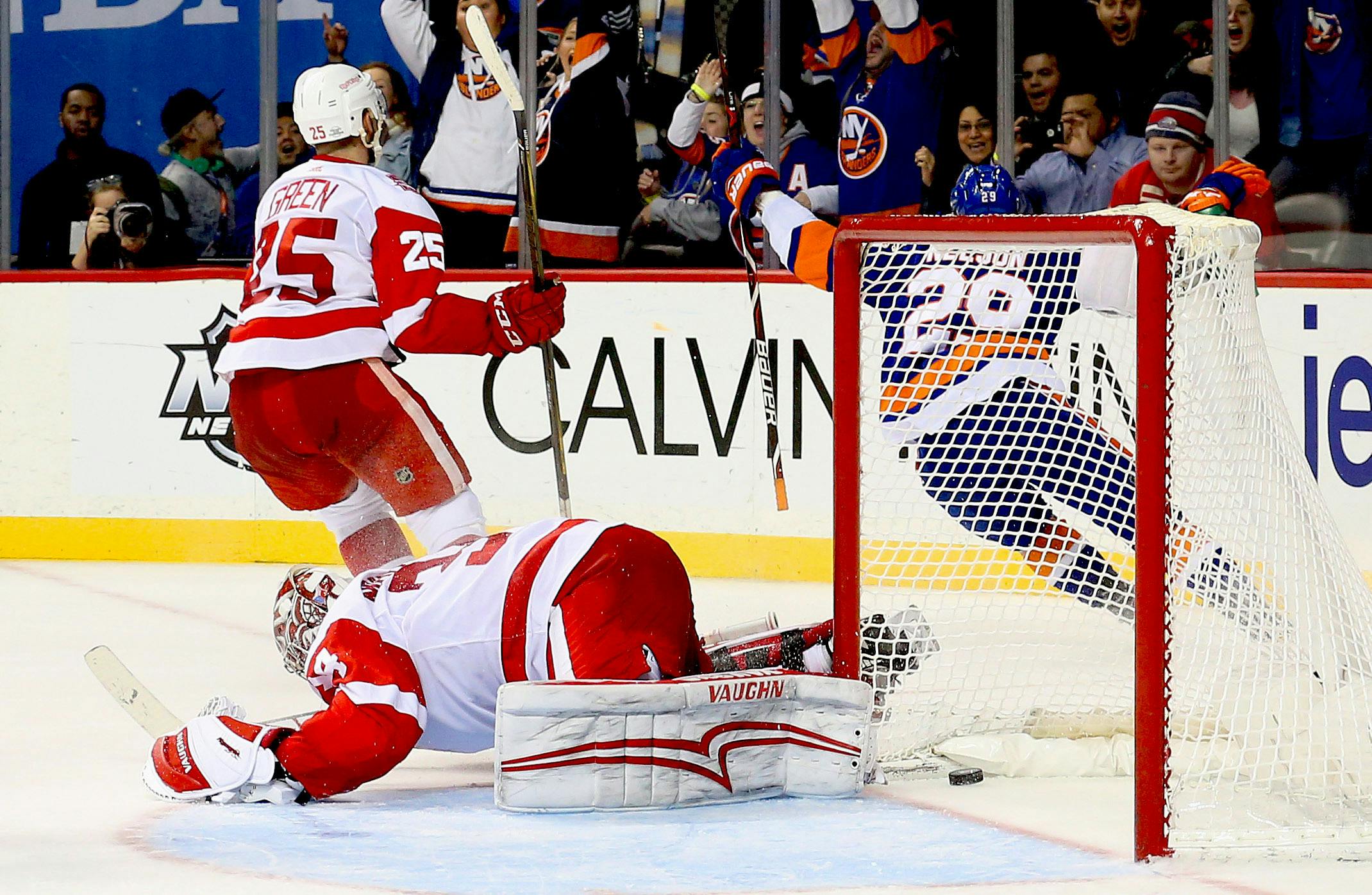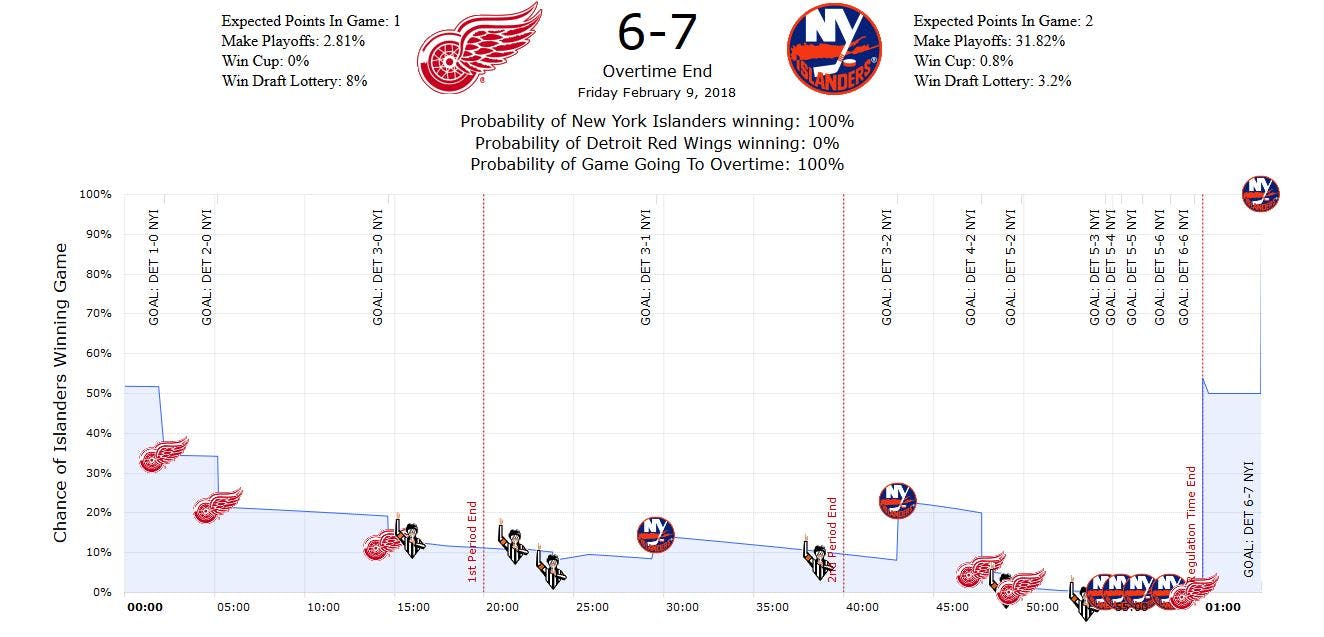How did the Red Wings blow a late 5-2 lead?

By Tom Mitsos
6 years agoIf there was any single game the Detroit Red Wings could point to and say, “This game defined our season,” it has to be Friday night’s loss.

The Red Wings managed to secure a point against the New York Islanders in a 7-6 overtime loss, but leading 5-2 with about 6:30 remaining should have guaranteed two points. In fact, according to Money Puck’s probability model, the Red Wings had a 100 percent chance of winning, even after Tyler Bertuzzi’s match penalty.

Win probability DET vs. NYI. (Courtesy Money Puck)
However, the Islanders did the unthinkable and scored four consecutive power-play goals on the five-minute power play to take a 6-5 lead, followed by a Mike Green goal with 29 seconds remaining that tied the game at 6-6. Brock Nelson completed the hat trick in overtime to secure the win for the Islanders.
It’s a final score that’s more apropos of an online game of NHL 18 than a regular season game in the actual NHL.
We know this team is inconsistent, that’s not breaking news. The inconsistency generally comes on a game-by-game basis.
For example, after losing 4-1 to the Pittsburgh Penguins on Jan. 13 in a game in which they were thoroughly dominated, the Red Wings came back the next day and shut out the Chicago Blackhawks for a dominant 4-0 win. Granted, these aren’t the Blackhawks of yesteryear that were steamrolling teams en route to winning Cups — this year’s Blackhawks have just 56 points in 54 games as of Saturday morning — but a 4-0 win against any opponent in the NHL is a sure sign of dominance.
Two days later against the Dallas Stars, the Red Wings came out flat, registering just 15 shots on goal (36 shot attempts according to Natural Stat Trick) and fell 4-2.
Almost a week later, they shut out the Carolina Hurricanes, a solid, young team that probably should be higher in the standings if not for the inconsistent goaltending of Scott Darling.
One game, we see a youthful team that uses its speed to push the puck up the ice and generate scoring chances, often catching teams flat-footed. The next game, we see the lackluster defense out of position or unable to generate a zone exit.
Anders Lee’s goal that cut Detroit’s deficit to 5-4 with about 4:30 remaining happened because the Red Wings’ PK — a unit that had been a strength this season — was out of position.
Nick Jensen and Danny DeKeyser are below the goal line trying to retrieve the puck. Watch as Dylan Larkin starts to glide toward the goal line (10-second mark of the video below) to offer support, but ends up leaving half of the defensive zone uncovered, which allows Mathew Barzal to rip a one-timer from the faceoff circle, and Lee knocks in the rebound.
After Brock Nelson scored the Islanders’ first power-play goal to cut the deficit to 5-3, the Red Wings started to panic and chased the Islanders around in their defensive zone. Aggressiveness has been key for the Red Wings’ PK units, but the overaggressiveness wasn’t structured, and the Islanders found holes in the defense.
About a minute later on Nick Leddy’s goal (20-second mark), we see more out-of-position play. Watch Justin Abdelakder drift to the hash marks almost where DeKeyser is covering Lee. Because he drifts that far down, Leddy is able to get a shot off — albeit, not a hard shot — and it beats Petr Mrazek to tie the game at 5-5.
And finally, on Josh Bailey’s go-ahead goal with less than two minutes remaining (32-second mark), we see more overaggressiveness that leaves both forwards out of position. Barzal enters the zone and draws both Darren Helm and Frans Nielsen with him. Barzal leaves the puck for Tavares, who has a wide-open lane to shoot or pass to Bailey. He opts to pass, and Bailey rips a one-timer past Mrazek.
We can sit here and discuss whether Bertuzzi’s slash warranted a match penalty (it didn’t), but that’s not the issue. Bertuzzi obviously knew he had a lapse in judgment and put his team in a tough spot. However, he’ll learn to control his emotions next time and skate away, hoping the referees catch the initial shove instead of his retaliation.
The issue is the Red Wings had controlled the play for roughly the entire game, and then adversity in the form of having to kill a five-minute power play caused them to lose control and play pond hockey rather than structurally sound defensive hockey.
Good teams don’t let minor setbacks affect their play. The Red Wings lost that confidence they held earlier in the game and played scared, which cost them a point in the standings and nearly cost them two if not for Green’s late goal.
You could argue that lost point is a good thing, keeping them one point closer to the bottom of the standings and a chance at drafting Rasmus Dahlin.
But it all but confirms this is not a team that has any chance at making a playoff push, and even if they did, this team is no different than the other three teams of the past four years that lost in the first round of the playoffs.
There are just too many inconsistencies.
Recent articles from Tom Mitsos





